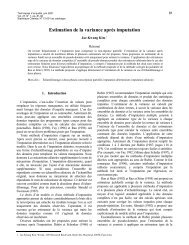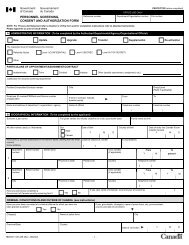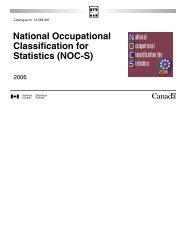Gender Differences in Police-reported Violent Crime in Canada, 2008
Gender Differences in Police-reported Violent Crime in Canada, 2008
Gender Differences in Police-reported Violent Crime in Canada, 2008
You also want an ePaper? Increase the reach of your titles
YUMPU automatically turns print PDFs into web optimized ePapers that Google loves.
Canadian Centre for Justice Statistics Profile Series<br />
Other violent offences<br />
Men more often the victims of robberies, while women more likely to be victims of crim<strong>in</strong>al<br />
harassment<br />
<strong>Police</strong>-<strong>reported</strong> data also <strong>in</strong>dicate that some notable gender differences exist among other categories of violent<br />
crime such as robbery, crim<strong>in</strong>al harassment and utter<strong>in</strong>g threats.<br />
Accord<strong>in</strong>g to police-<strong>reported</strong> rates, women were the victims of robbery about half as often as men, but were<br />
almost 3 times more likely to suffer crim<strong>in</strong>al harassment. In <strong>2008</strong>, while males accounted for 65% of robbery<br />
victims, 8 females were victims <strong>in</strong> 73% of crim<strong>in</strong>al harassment crimes (Table 5, Table 6).<br />
While rates for utter<strong>in</strong>g threats were more similar for men (184 per 100,000 population) and women<br />
(156 per 100,000 population), there were some differences between the sexes <strong>in</strong> terms of who was identified as<br />
the perpetrator.<br />
Similar to patterns seen among physical and sexual assaults, female victims of crim<strong>in</strong>al threats were more often<br />
victimized by a spouse or dat<strong>in</strong>g partner than were male victims. In particular, the proportion of females (18%)<br />
threatened by a spouse or ex-spouse was 6 times higher compared to their male counterparts (3%). The proportion<br />
of female victims threatened by a current or former dat<strong>in</strong>g partner (12%) was also about 6 times higher than for male<br />
victims (2%) of utter<strong>in</strong>g threat offences. In contrast, males (24%) were about twice as likely as females (12%) to be<br />
threatened by a stranger.<br />
Summary<br />
<strong>Police</strong>-<strong>reported</strong> data show that males and females experience similar rates of violent victimization. However,<br />
there are some tell<strong>in</strong>g differences between the sexes <strong>in</strong> the nature of their victimization. For <strong>in</strong>stance, males and<br />
females experience different types of physical assault. Males were more likely to be victims of more serious<br />
assaults (level 2 and 3), and have a weapon used aga<strong>in</strong>st them; while females were more likely to be victims of<br />
common assault, result<strong>in</strong>g <strong>in</strong> fewer <strong>in</strong>juries than their male counterparts. Furthermore, female victims of physical<br />
assault were more often victimized by a spouse, whereas males were more often assaulted by someone who was<br />
not known to them such as a stranger. In addition, females were 10 times more likely than males to be victims<br />
of sexual assault.<br />
Methodology<br />
Incident-based Uniform <strong>Crime</strong> Report<strong>in</strong>g Survey<br />
The Incident-based Uniform <strong>Crime</strong> Report<strong>in</strong>g (UCR2) Survey collects detailed <strong>in</strong>formation on <strong>in</strong>dividual crim<strong>in</strong>al<br />
<strong>in</strong>cidents <strong>reported</strong> to police, <strong>in</strong>clud<strong>in</strong>g characteristics of victims, accused persons and <strong>in</strong>cidents. The <strong>2008</strong> data are<br />
based upon <strong>in</strong>formation <strong>reported</strong> by police services cover<strong>in</strong>g 98% of the population of <strong>Canada</strong>.<br />
The UCR2 Trend Database conta<strong>in</strong>s historical data that permit the analysis of trends <strong>in</strong> the characteristics of<br />
<strong>in</strong>cidents, accused and victims, such as victim-accused relationship. This database currently <strong>in</strong>cludes 63 police<br />
services that have <strong>reported</strong> to the UCR2 Survey consistently s<strong>in</strong>ce 1999. These respondents accounted for 54% of<br />
the population of <strong>Canada</strong> <strong>in</strong> <strong>2008</strong>. Prov<strong>in</strong>cially, this database accounts for 36% of the population of Newfoundland<br />
and Labrador, 18% of the population of New Brunswick, 99% of the population of Quebec, 52% of the population of<br />
Ontario, 47% of the population of Saskatchewan, 55% of the population of Alberta and 14% of the population of<br />
British Columbia.<br />
8. Accord<strong>in</strong>g to the General Social Survey 2004, 51% of robberies were <strong>reported</strong> to the police.<br />
12 Statistics <strong>Canada</strong> – Catalogue no. 85F0033M, no. 24
















